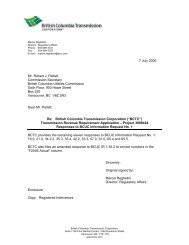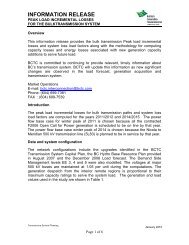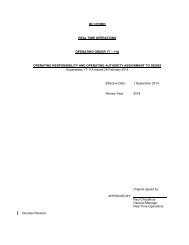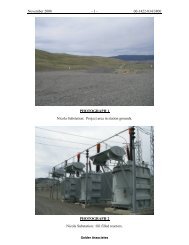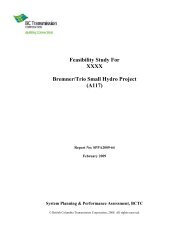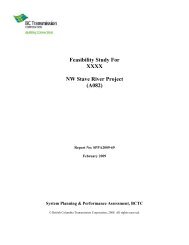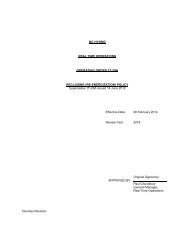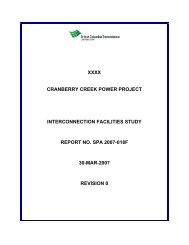Evidence on the Adequacy of First Nations Consultation - BC Hydro ...
Evidence on the Adequacy of First Nations Consultation - BC Hydro ...
Evidence on the Adequacy of First Nations Consultation - BC Hydro ...
Create successful ePaper yourself
Turn your PDF publications into a flip-book with our unique Google optimized e-Paper software.
6. Allan Smith<br />
In 1984, <strong>on</strong> behalf <strong>of</strong> <strong>the</strong> U.S. Army Corps <strong>of</strong> Engineers, Smith prepared a report entitled Kutenai<br />
Indian Subsistence and Settlement Patterns, Northwest M<strong>on</strong>tana. Although <strong>the</strong> reas<strong>on</strong>s for<br />
commissi<strong>on</strong>ing <strong>the</strong> report c<strong>on</strong>cerned Ktunaxa groups in <strong>the</strong> Lake Koocanusa area <strong>of</strong> M<strong>on</strong>tana, Smith<br />
pointed out [p. 7] that <strong>the</strong> study should take a look at <strong>the</strong> whole <strong>of</strong> <strong>the</strong> Ktunaxa range:<br />
The Lake Koocanusa groups were, however, by no means limited in <strong>the</strong>ir subsistence foraging to <strong>the</strong>ir<br />
own band lands. In <strong>the</strong>ir food quest <strong>the</strong>y wandered freely over <strong>the</strong> total territory <strong>of</strong> <strong>the</strong> Upper Kutenai<br />
and seas<strong>on</strong>ally even joined Lower Divisi<strong>on</strong> people in exploiting <strong>the</strong>ir downriver food resources.<br />
In assessing <strong>the</strong> origins <strong>of</strong> <strong>the</strong> Ktunaxa, Smith writes [preface, p. vii]:<br />
A tentative rec<strong>on</strong>structi<strong>on</strong> <strong>of</strong> <strong>the</strong> subsistence and settlement patterns <strong>of</strong> <strong>the</strong> Upper Kutenai suggests four<br />
successive protohistoric and early historic periods: (1) a prehorse, prefirearms, prebis<strong>on</strong> period when<br />
hunting, fishing, and plant ga<strong>the</strong>ring were pursued year-round in a relatively balanced manner west <strong>of</strong><br />
<strong>the</strong> C<strong>on</strong>tinental Divide by small wandering camps; (2) a period when mid-winter foot treks for bis<strong>on</strong><br />
meat east <strong>of</strong> <strong>the</strong> Rockies were initiated by certain groups near <strong>the</strong> mountains but o<strong>the</strong>rwise life was little<br />
changed; (3) a late prehistoric period which saw <strong>the</strong> introducti<strong>on</strong> <strong>of</strong> <strong>the</strong> horse, and a significant turn <strong>on</strong><br />
<strong>the</strong> part <strong>of</strong> several bands toward equine-dependent bis<strong>on</strong> hunting <strong>on</strong> <strong>the</strong> Plains during warmer seas<strong>on</strong>s<br />
to complement <strong>the</strong> earlier winter bis<strong>on</strong> hunts <strong>on</strong> foot, toward a decreased utilizati<strong>on</strong> <strong>of</strong> <strong>the</strong> traditi<strong>on</strong>al<br />
food resources within <strong>the</strong>ir tribal homeland, and toward fewer but larger and more sedentary settlements<br />
when resident in <strong>the</strong>ir own territory; and (4) an early postc<strong>on</strong>tact period when firearms were obtained,<br />
bis<strong>on</strong> hunting received a still greater emphasis <strong>on</strong> <strong>the</strong> part <strong>of</strong> most <strong>of</strong> <strong>the</strong> Upper people, and certain<br />
minimal elements <strong>of</strong> Western culture were adopted.<br />
Smith evaluates <strong>the</strong> relevant work <strong>on</strong> traditi<strong>on</strong>al territory d<strong>on</strong>e by numerous ethnographers,<br />
sometimes addressing shortcomings he perceives in <strong>the</strong>ir analyses. Like Turney-High, he points out<br />
that Verne Ray spent very little effort in ga<strong>the</strong>ring Ktunaxa data. His discussi<strong>on</strong> <strong>of</strong> Teit’s work is<br />
also interesting. For example, he notes [p.12] that “Teit recognizes no distinct Lakes “tribe” in <strong>the</strong><br />
Arrow Lakes sector and al<strong>on</strong>g <strong>the</strong> Columbia to <strong>the</strong> north.” He also asserts that “Teit’s findings seem<br />
to establish bey<strong>on</strong>d argument that <strong>the</strong> Kinbasket group represented an early postc<strong>on</strong>tact thrust <strong>of</strong><br />
various eastern Shuswap peoples into aboriginal territory <strong>of</strong> <strong>the</strong> Columbia Lakes Band <strong>of</strong> <strong>the</strong><br />
Kutenai.” 80<br />
His map [Figure 11] shows <strong>the</strong> nor<strong>the</strong>rn boundary <strong>of</strong> Ktunaxa between present day D<strong>on</strong>ald and<br />
Golden, crossing eastward through <strong>the</strong> Rockies via Howse Pass. It draws <strong>the</strong> western boundary <strong>of</strong><br />
<strong>the</strong> Ktunaxa roughly in line with <strong>the</strong> Purcell Mountains, denying <strong>the</strong> Ktunaxa a share <strong>of</strong> <strong>the</strong><br />
Revelstoke and Arrow Lakes areas.<br />
Smith appears to suggest that it’s more than coincidence that Ray, who spent a great deal <strong>of</strong> time<br />
am<strong>on</strong>g <strong>the</strong> Fort Colville Indians, and Teit who lived with and married into <strong>the</strong> Shuswaps delineate<br />
vastly greater areas for <strong>the</strong>se tribes than o<strong>the</strong>r ethnographers. This appears to be a gentle criticism<br />
that some ethnographers have exhibited a bias in favour <strong>of</strong> <strong>the</strong>ir subject tribes when it comes to<br />
delineating traditi<strong>on</strong>al boundaries.<br />
80 Although much <strong>of</strong> <strong>the</strong> Columbia Lakes Band derives from <strong>the</strong> followers <strong>of</strong> Chief Michelle, who arrived from <strong>the</strong> U.S.<br />
in <strong>the</strong> 1850s, <strong>the</strong>y were joined by o<strong>the</strong>r Ktunaxas whose ancestors had occupied <strong>the</strong> area for a very l<strong>on</strong>g time.<br />
43<br />
Page 187 <strong>of</strong> 200






